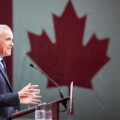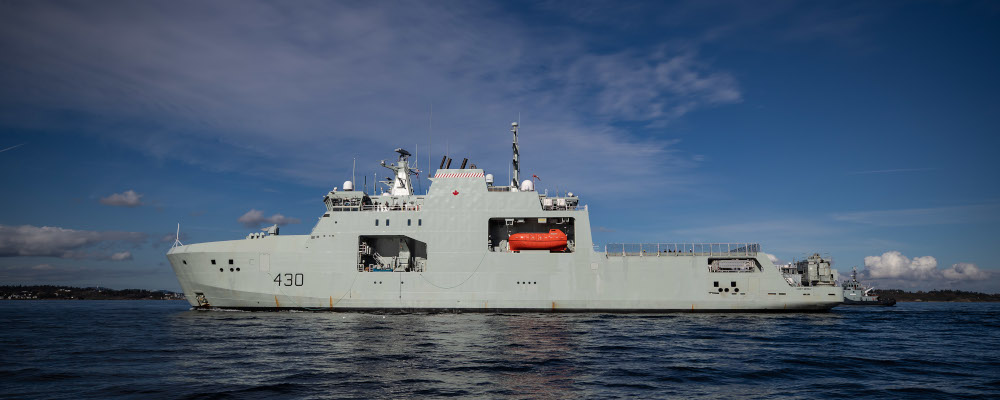The science is clear: climate change is happening. As it accelerates, melting Arctic ice is giving way to vast stores of resources and newly accessible shipping routes in Canada’s North.
Russia and China are investing heavily in visions of regional dominance and, with Russian President Vladimir Putin ordering a full-scale invasion of Ukraine last week, it’s clear that we are in a new world, with new dangers for the West.
Canada must be ready to protect the 40 percent of its national territory in the Arctic from illegal fishing, resource extraction, and unwanted shipping traffic.
But without the ability to project its sovereignty to the country’s northernmost regions, the Canadian government risks, for all practical purposes, forfeiting it there. Policymakers are only just beginning to take note.
For instance, the Royal Canadian Navy has recently sailed a new Arctic patrol ship through the Northwest Passage for the first time in almost 60 years, re-entering a region long considered a domain of the Coast Guard.
There is some other good news. This ship is one of six nimble vessels now built or planned to bolster the RCN’s ability to operate in the North. Newly acquired unmanned drones and soon-to-be-purchased fighter jets will undoubtedly find use as northern surveillance tools. And the Coast Guard also plans to add two new heavy icebreakers to its fleet.
The bad news is that an evaluation of Canada’s plans reveals several outstanding capability weaknesses that do not seem to be urgent priorities to fix.
First, Canada is only starting to look below the Arctic waters. Its existing fleet of diesel-powered submarines will need to be decommissioned between 2036 and 2042. The Department of National Defence has started a project to look at a replacement, but they do not know what shape it will take or how much it will cost.
This delay is concerning, as major Canadian military acquisition projects take 15 years to complete on average. Moreover, without submarines that can travel under Arctic ice, Canada loses much of its ability to surveil and respond to threats quickly.
Second, Canada’s main eyes in the Arctic sky are set to come offline relatively soon. The military uses the Canada Space Agency’s RADARSAT satellite system to monitor ship activity in the North and assert Canadian sovereignty. However, this system will come offline in 2026 and a replacement will not be launched until 2033.
That leaves a seven-year information gap at a time when interest in the Arctic is on the rise.
And finally, NORAD’s North Warning System, operated by a partnership between Canada and the United States, will be obsolete by 2025. This system detects Russian bombers and ICBMs that may fly over the poles, which are becoming increasingly sophisticated.
With estimates as high as $11 billion and the extended time it will take to design and install a replacement, conversations on modernizing the system are coming far too late.
Compare this to the investments of Canada’s Arctic competitors. Russia, for one, is building new military bases, flying planes with increased vigour, and engaging in a shipbuilding frenzy. In addition, it recently made news with a notable show of northern strength, smashing three of its nuclear submarines through the Arctic ice at the same time while fighter jets flew overhead.
China, meanwhile, is deploying icebreakers and increasing security research projects in the north. The east-Asian power has, questionably, branded itself as a “near-Arctic” state.
Let’s be clear again about what is at stake in the north. Canada will not face the same time of aggressive interference faced by Russia’s and China’s neighbours in Ukraine or Taiwan. Instead, the threat comes from unwanted, foreign-supported advances into its national waters for exploitative purposes.
As such, Canada must take care not to overmilitarize its Arctic—a northern arms race would benefit nobody. Indeed, the Arctic Council, on which both Canada and Russia sit, is founded on the principle that cooperation among nations in the northern region is key to the region’s future.
But Canada must still have the ability to readily exert its legal authority in the far north. This is particularly true as the United States, whom Canada may have otherwise been able to turn to for support, disputes Canada’s sovereignty over the Northwest Passage.
Canada can start by immediately working to plug the holes in its northern presence, particularly as it relates to its ability to gather information.
Ultimately, Canada’s slowness to take its armed presence in the Arctic seriously is indicative of a more significant trend of regional neglect. Its claim to sovereignty over the far north rests on the long, historical presence of Inuit communities in the area. Yet, Canada has failed to invest in the economies and infrastructure of these communities.
Take housing as just one example. Nunavut has a housing shortage of about 3,000 units (a substantial amount for a territory of about 37,000 people). Moreover, existing units are often mouldy and run-down.
The nation has not meaningfully worked to do right by the Indigenous communities it relies on for its claims of northern sovereignty. It does not even have the room to house the servicepeople it will need to protect its northern sovereignty in the years to come.
Nor is Canada’s port infrastructure in the north sufficient to manage increased shipping traffic, search and rescue missions, or security response missions. Its primary investment—the Nanisivik Naval Station—is not yet built despite an original opening target for 2013 and a significantly scaled-back port design.
Clearly, Canada is failing to plan for the future of the Arctic from a military, economic, and infrastructure standpoint.
The nation faces a choice: will Canada continue to neglect the tools it needs to guard its national sovereignty in the north, or will it finally take its status as a major Arctic nation seriously? Climate change is already upon us. Canada’s rivals realize it.
Let’s hope the Great White North realizes it too.
Recommended for You

Alberta is the only province where the population grew in third quarter of 2025: Statistics Canada

‘Insanely unpredictable’: From a fresh PM to floor crossings, Hub Politics reacts to the big stories of 2025

‘Discombobulating’: Alberta at the centre of Canada’s 2025 stress test

Kids may not want a lump of coal for Christmas, but the world still values the key Canadian resource




Comments (0)